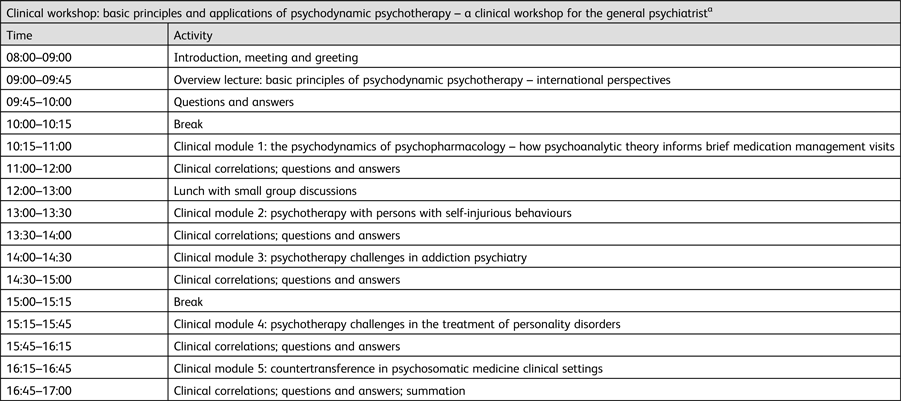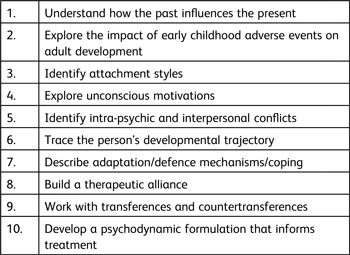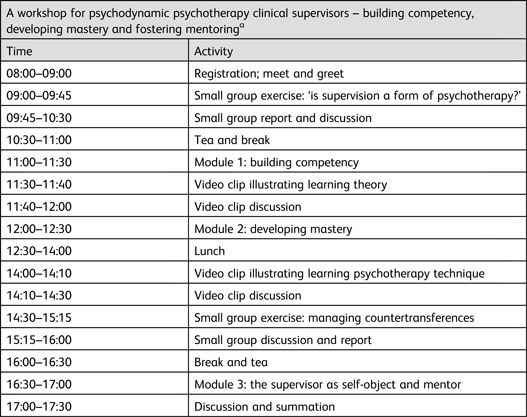Populous countries in the Asia–Pacific region have adequate psychiatric residency curricula but inadequate psychotherapy clinical supervision, and the paucity of training programs reflects how underserved psychiatry is in this zone (Ruiz & Bhugra, Reference Ruiz and Bhugra2008; Tasman et al, Reference Udomratn2009). Cognitive behavioural therapy is systematically taught in most of Asia but other modalities such as supportive, interpersonal, dialectic behavioural, group, marital, family and psychodynamic psychotherapies are not well supervised. It is challenging to bridge these gaps given the demands of high volume services and few formally trained supervisors. Initiatives have been implemented to improve psychotherapy training in Asia (Alfonso et al, Reference Alfonso, Summers, Kronfol, Fountolakis and Javed2018). The most widely recognised among these initiatives is the China American Psychoanalytic Alliance program, which is largely conducted through videoconferencing (Fishkin et al, Reference Fishkin, Fishkin and Leli2011). This article describes an abridged program designed to provide advanced psychotherapy training in underserved areas with limited pedagogical resources. Although the program was piloted in Asia, our hope is that it could be adapted or replicated in other areas with similar needs.
The World Psychiatric Association (WPA) Psychotherapy, Education in Psychiatry, and Psychoanalysis in Psychiatry Sections identified that Asian psychiatrists have a keen interest in improving psychodynamic psychotherapy education. Liaisons with the Royal College of Psychiatrists in Thailand, the Malaysian Psychiatric Association and the University of Indonesia gave rise to our multinational, collaborative, pedagogic endeavour (Alfonso et al, Reference Alfonso, Summers, Kronfol, Fountolakis and Javed2018). The WPA pilot program was designed to take place over 5 years, targeting three countries (see Table 1). It was designed to be self-sustaining – with the aim of improving the psychotherapy skills of those enrolled in study activities and teaching psychiatrists how to supervise – so that, after completion, psychiatrists could work effectively as psychotherapy supervisors.
Table 1 Psychiatric resources in South East Asian countries

Phase 1: full-day workshops to improve clinical skills
Full-day psychodynamic psychotherapy workshops took place at meetings sponsored by the national psychiatric societies in Jakarta, Surabaya, Kuala Lumpur and Bangkok between 2013 and 2014. The hosting psychiatric society selected local psychiatrists to run workshop modules according to the experts' areas of interest (see Table 2). Clinical correlations and applicability of psychodynamic thinking in a variety of settings were emphasised. Attendance ranged from 35 to 50 people; a manageable number for the maintenance of didactic group cohesion. Upon completion, workshop co-leaders were invited to become members of WPA sections. To stimulate continuity, a follow-up advanced course was conducted during the same academic year for each of the three countries.
Table 2 Advanced psychodynamic psychotherapy workshop template

a Each module is co-facilitated by a World Psychiatric Association scholar and a local prominent expert in the relevant field.
Phase 2: one-semester advanced psychodynamic psychotherapy courses
The 6-month course included a virtual classroom, a core curriculum of 40 articles and textbook chapters, a moderated email discussion forum and on-site learning in each country. Courses were given sequentially in Thailand, Malaysia and Indonesia from 2014 to 2016. Classes took place every other week for 90 min over videoconference, and the 10th and last class for each group took place in person in the host country, at the same time and place of the national psychiatric societies’ meetings. Each course had two to three co-teachers and eight students. All authors of this paper served as co-teachers. The co-teachers selected one student coordinator for each group: Natchanan Charatcharungkiat (Thailand), Najwa Hanim Rosli (Malaysia) and Rizky Aniza Winanda (Indonesia). The national societies monitored the competitive student application and selection process.
Classes were clinically focused (case-conference style): each student was required to present a psychotherapy case concisely in writing and orally, with appropriate formulations and questions for discussion. Readings were assigned according to the clinical relevance to each case, and students were required to comment on theory and technique. Classes were conducted bilingually in English and Thai and in Bahasa Indonesian and Bahasa Malay, with the student coordinator serving as translator while trying to maintain English as the common language. Informed consent was requested using secure videoconferencing technologies and file encryption, which protected patient confidentiality.
Follow-up workshops are in progress, encouraging graduates to take on supervision responsibilities. The first workshop on supervision took place in March 2017 in Malang, East Java, and the second is scheduled in Kuching, Borneo, Malaysia in July 2017.
Phase 3: training of psychodynamic psychotherapy supervisors
Phase 3 improves the supervisory skills of psychiatrists. Workshops combine small group exercises and brief lectures, followed by interactive discussions. An exercise examines the fine line between clinical supervision and psychotherapy of a supervisee, and how to navigate between one dimension and the other. Module one focuses on delineating competencies in psychodynamic psychotherapy (see Table 3) and ways to operationalise these in didactic practice through apprenticeship. Module two examines supervision as a process of progressive development, where mastery is achieved by moving along a continuum of formative educational milestones. A small group exercise focuses on exploring countertransferences in a systematic way, including states of boredom, rescue fantasies, rage, inadequacy, sadness and erotic feelings. Module three traces the developmental progression of how supervisors help advance supervisees from inexperience to expertise, ego supportively, by becoming self-objects and therapeutic role models (see Table 4).
Table 3 Ten essential psychodynamic psychotherapy competencies

Table 4 Clinical supervision workshop template

a Workshop scheduled on 17 July 2017 in Sarawak, Borneo. Workshop facilitator: César A. Alfonso; workshop leaders: Hazli Zakaria, Aili Hashim, Aida Adlan, Eizwan Hamdie Yusoff, Ng Yin Ping and Lai Mee Huong. Workshop participants: psychiatrists practising in Malaysia who are currently doing psychodynamic psychotherapy clinical supervision or are planning to supervise trainees.
Phase 4: ongoing continuing education
Two graduates from Thailand are organising a 1-year psychotherapy journal club over an email list server for an in-depth review of 12 recent articles published in the scientific journal Psychodynamic Psychiatry. Aunjitsakul and Anantapong created a list serv of all graduates from the three countries to discuss one article per month. In addition, authors of journal articles and journal editors were invited to mentor and participate in the discussion. The core group of approximately 30 graduates and co-teachers are becoming, in essence, a network of psychodynamic psychotherapy supervisors in South East Asia, a region where psychotherapy training institutes do not exist.
Phase 5: creating an international mentoring program
Course graduates and co-teachers have expressed the need to systematise a mentoring program to achieve self-sustainment. Graduates are in the process of forming an International Mentoring Association of Psychodynamic Psychiatrists with the goal of organising regional scientific meetings, encouraging publications, and advancing the practice of intensive psychotherapy through collaborative efforts, using WPA intersectional members as mentors.
Cultural adaptation of intensive psychotherapies in Asia
Cultural diversity needs to be taught beyond culture-bound generalities or mechanically constructed formulations. Nuances such as symbolic meaning that may be alien to the clinicians' way of thinking, idiosyncratic ways of communicating distress, and exploring idioms of distress through detailed inquiry with neutrality are encouraged under clinical supervision. Every clinical interaction could be construed as a transcultural exchange, even when cultural similarities seem to outweigh differences (Udomratn, Reference Woon, Kanapathy and Zakaria2008; Alfonso et al, Reference Alfonso, Summers, Kronfol, Fountolakis and Javed2018).
Asians experience communicating and relating with others as more presentational than representational. Europeans, Americans and those in globalised megalopolises rely more on articulate verbal expressions in communicating and functioning representationally (Bollas, Reference Bollas2013). Asians engaging in intensive psychotherapy tend to experience discourse as an ambiguous and co-constructed human activity. Psychotherapy generally pursues lucidity in a deductive fashion. This tension between deductive reasoning and hermeneutics causes a dilemma when practising psychotherapy in Asia. Appreciating relationality may bridge this tension and can make psychotherapy more culturally appropriate for Asian people. Mitchell's matrix of non-reflective behavioural relationality, relationality transpiring around affective permeability, relationality as an experience that is organised into self-other configurations, and relationality as intersubjectivity (Mitchell, Reference Mitchell2014) could guide trainees engaging in intensive psychotherapies. In our experience, a transtheoretical psychodynamic approach allows for theories to be used heuristically rather than as presupposed constructs, and this prevents theories from being imposingly applied to the care of patients (Alfonso et al, Reference Alfonso, Adlan and Zakaria2016).
Measuring the impact of the pilot program
To date, 15 course graduates have joined the WPA Psychotherapy Section and all co-teachers joined the Psychoanalysis in Psychiatry Section. Graduates and co-teachers have presented at regional meetings in Hong Kong and Taipei, and at European congresses in Florence and Berlin. Three publications in peer-reviewed journals have resulted (Alfonso et al, Reference Alfonso, Adlan and Zakaria2016; Loo et al, Reference Loo, Ang and Subhas2017; Woon et al, Reference Tasman, Sartorius and Saraceno2017) and four others are in press.
Approximately 150 participants attended phase-1 workshops. In Malaysia, a modification of the workshop has been replicated three times with groups of early career psychiatrists. Phase-2 trainees were formally surveyed and phase-3 trainees will be surveyed upon completion of the program.
A total of 95.6% of phase-2 trainees completed a survey to rate the one-semester course, with 87.5% reporting to have done the required assignments. All trainees said they were satisfied with supporting teaching materials/media for the course at a high or the highest level, and they left positive comments on the video technology. We used a five-point Likert scale to measure the learning of diverse theoretical constructs. A total of 71.4% rated understanding ‘all’ or ‘most’ of Freud's metapsychological hypotheses, ego psychology, defence mechanisms, object relations theory, attachment theory, and the psychodynamics of narcissism, borderline character structure, depression, relevance of the biopsychosocial model and the concept of allostatic load. A slightly less favourable result was that only 62.5% of trainees adequately understood the psychodynamics of obsessive-compulsive symptoms, eating disorders, addictions, and anxiety disorders.
When asked about what was most beneficial about the course, trainees commended a course format that emphasises group cohesion, support and how to translate theory into practice. The difficulties reported included complexity of the readings and little time to complete assignments. Specific suggestions included extending the course duration and time of the first class, adding additional time to further discuss readings, higher involvement of co-teachers, and watching sample video clips of psychodynamic psychotherapy sessions conducted by experts.
Conclusions
As overwhelming as it may seem to provide intensive psychotherapy training in underserved communities with scarce resources, academics can bridge the service and learning gaps through international collaborations. Innovations in pedagogical methods by using video and internet tools, emphasising cultural adaptations, attending to inclusiveness and encouraging mentoring result in effective learning. Although the long-term impact of this pilot program needs to be examined, similar models could be replicated in other regions of the world where psychotherapy in psychiatry is underrepresented.







eLetters
No eLetters have been published for this article.